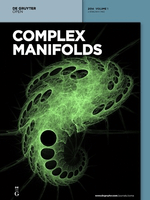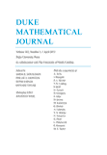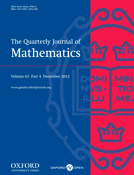
Complex Manifolds
Scope & Guideline
Connecting Scholars in the Realm of Topology and Geometry
Introduction
Aims and Scopes
- Complex Geometry and Algebraic Structures:
The journal emphasizes the exploration of complex geometric structures, including but not limited to complex manifolds, vector bundles, and sheaf theory. Research often investigates the properties and relationships between these structures, contributing to a deeper understanding of the underlying algebraic frameworks. - Differential Geometry and Topology:
A significant portion of the published works addresses differential geometric aspects of complex manifolds, such as curvature, holonomy, and metric structures. This includes studies on Kähler and Hermitian manifolds, focusing on their topological properties and invariants. - Deformation Theory and Moduli Spaces:
Research on deformation theory, particularly concerning moduli spaces of various geometric objects, is a core area of interest. This includes the study of stably irreducible sheaves, rational curves, and other deformation categories relevant to complex geometry. - Applications to Mathematical Physics:
The journal also features works that apply complex manifold theory to mathematical physics, particularly in areas like string theory, quantum field theory, and the study of integrable systems. This interdisciplinary approach enhances the relevance of complex manifolds in broader scientific contexts. - Singularity Theory and Analytic Structures:
The exploration of singularities in complex analytic functions and vector fields is another focal point, contributing to the understanding of how singularities affect the geometry and topology of complex manifolds.
Trending and Emerging
- Transcendental Geometry and Singularities:
Recent papers highlight a growing interest in the geometry of transcendental singularities, indicating a trend towards understanding complex analytic functions in more nuanced ways. This emerging theme suggests an integration of analytic methods with geometric insights. - Locally Conformal Kähler (LCK) Structures:
There has been an increase in research focusing on LCK manifolds, particularly their properties and applications. This trend reflects a broader interest in the interplay between complex and symplectic geometry, and its implications for various mathematical theories. - Geometric Structures in Higher Dimensions:
The exploration of geometric structures in higher-dimensional manifolds, including those with specific curvature properties and special holonomy, is becoming more prominent. This trend indicates a shift towards more abstract and generalized concepts in complex geometry. - Moduli Problems and Stability Conditions:
An increasing number of publications discuss moduli spaces and stability conditions, particularly in the context of sheaves and vector bundles. This reflects a growing recognition of the importance of stability in the classification and deformation of complex structures. - Interdisciplinary Applications:
The trend towards applying complex manifold theory to various fields, including mathematical physics and string theory, is gaining momentum. This interdisciplinary approach not only enhances the relevance of complex manifolds but also fosters innovative research methodologies.
Declining or Waning
- Classical Results in Complex Geometry:
There has been a noticeable decline in papers focused on classical results and foundational aspects of complex geometry, suggesting a shift towards more innovative and contemporary topics. This may reflect a growing interest in novel applications and advanced research methodologies. - Elementary Techniques in Differential Geometry:
The journal has seen fewer publications that rely on basic or traditional techniques in differential geometry, indicating a possible move towards more complex and sophisticated analytical methods that engage with advanced theories and computational approaches. - Low-Dimensional Topology:
Research themes centered around low-dimensional topology, particularly those that intersect with complex manifolds, appear to be waning. This may correlate with a broader trend in the field moving towards higher-dimensional and more abstract geometric constructs.
Similar Journals

ADVANCES IN GEOMETRY
Catalyzing Discussions in Cutting-edge Geometry ResearchADVANCES IN GEOMETRY is an esteemed journal dedicated to the dissemination of innovative research in the field of geometry and topology. Published by WALTER DE GRUYTER GMBH, this journal serves as a vital platform for researchers and practitioners from around the globe, reflecting the latest advancements and stimulating critical discussions in the subject. With an ISSN of 1615-715X and an E-ISSN of 1615-7168, it enjoys a reputable standing, evidenced by its classification in the Q3 category of the geometry and topology domain according to 2023 metrics. Although the journal operates under standard access options, it is committed to fostering scholarly communication and raising the visibility of high-quality research. The journal's impact on the field is underscored by its Scopus rank of #77 out of 106, placing it in the 27th percentile. Since its inception in 2001, ADVANCES IN GEOMETRY has continually blossomed, promising a convergence of ideas and methodologies that drive forward the understanding of geometric theory. This journal is essential reading for those eager to stay at the forefront of geometry and topology research.

DUKE MATHEMATICAL JOURNAL
Exploring New Dimensions in MathematicsDUKE MATHEMATICAL JOURNAL, published by DUKE UNIVERSITY PRESS, stands as a premier journal in the field of Mathematics, with an esteemed reputation reflected in its Q1 ranking in Mathematics (miscellaneous) for 2023 and its status as one of the top 50 journals in General Mathematics according to Scopus rankings. Since its inception in 1935, this journal has committed to publishing high-quality research that pushes the boundaries of mathematical knowledge and theory. With a broad scope that encompasses various areas within mathematics, the journal serves as a vital platform for disseminating innovative ideas and findings. Although it does not offer Open Access options, its rigorous peer-review process ensures the integrity and excellence of the work it publishes, making it an essential resource for researchers, professionals, and graduate students aiming to contribute to or stay informed about the rapid advancements in this dynamic field. For more information, visit its office at 905 W MAIN ST, STE 18-B, DURHAM, NC 27701.

GEOMETRIC AND FUNCTIONAL ANALYSIS
Fostering Excellence in Geometric and Functional AnalysisGeometric and Functional Analysis, ISSN 1016-443X, is a prestigious academic journal published by Springer Basel AG in Switzerland, renowned for its impactful contributions to the fields of geometry and analysis. With a notable Q1 ranking in both Analysis and Geometry and Topology, the journal has established itself as a leading voice in the mathematical community, garnering respect and attention with its Scopus classification — ranking 6th in Geometry and Topology and 26th in Analysis. Since its inception in 1991, it has served as a platform for rigorous research, presenting original articles that push the boundaries of mathematical understanding. Researchers, professionals, and students seeking high-quality, peer-reviewed content in these domains will find valuable insights and developments within its pages. While primarily subscription-based, the journal's extensive reach and influence make it an essential resource for advancing knowledge in geometric and functional analysis.

JOURNAL OF DIFFERENTIAL GEOMETRY
Elevating mathematical discourse through rigorous research.JOURNAL OF DIFFERENTIAL GEOMETRY, a premier publication by INT PRESS BOSTON, INC, has established itself as a leading forum for the dissemination of high-quality research in the fields of differential geometry, algebra, and analysis. With an impressive history that spans from 1967 to 2024, this journal is recognized for its rigorous peer-reviewed articles, contributing significantly to the advancement of mathematical theories and innovative approaches. Notably, the journal boasts a Q1 ranking in key categories such as Algebra and Number Theory, Geometry and Topology, and Analysis, reflecting its pivotal role within the mathematics community. Its Scopus rankings reinforce its reputation, placing it among the top-tier journals in its respective fields, with a 97th percentile ranking in Algebra and Number Theory, further emphasizing its influence. While the journal does not offer Open Access options, it remains a critical resource for researchers, professionals, and students aiming to stay at the forefront of developments in differential geometry and related domains. Engage with groundbreaking research and explore new methodologies that are shaping the future of mathematics.

Journal of Geometry
Exploring the Dimensions of Mathematical InsightJournal of Geometry, published by SPRINGER BASEL AG, is a prominent scholarly journal, ISSN 0047-2468 and E-ISSN 1420-8997, dedicated to the field of Geometry and Topology. Hailing from Switzerland, this journal has been a vital resource for researchers since its inception in 1971 and continues to contribute invaluable insights into geometric theories and applications through 2024. With a HIndex that reflects its academic impact, the journal currently ranks in the Q3 category for Geometry and Topology, placing it within the top half of publications in its field, as evidenced by its Scopus ranking of #71 out of 106 in Mathematics, Geometry, and Topology. The Journal of Geometry serves as a platform for original research, reviews, and special issues that address foundational and cutting-edge topics, making it an essential read for mathematicians, educators, and students alike. While it is not an open-access publication, the journal maintains accessibility through institutional subscriptions, ensuring that its significant contributions to geometry are readily available to the academic community.

HOUSTON JOURNAL OF MATHEMATICS
Bridging Theory and Application in MathematicsHOUSTON JOURNAL OF MATHEMATICS, published by the University of Houston, serves as a valuable platform for disseminating significant findings in the field of mathematics, specifically within the realm of miscellaneous mathematics. Despite its current categorization in Q4 for 2023, the journal plays a crucial role in fostering academic discussion and exploration among researchers, professionals, and students alike. With its ISSN 0362-1588, the journal has been publishing original research since 1996, with a recent gap filled from 2022 to 2023, thereby continuing to contribute to the mathematical community. While it does not currently offer open access options, the journal's commitment to quality research maintains its relevance within the field and invites submissions that can elevate its standing. Located in the vibrant city of Houston, Texas, the journal not only emphasizes theoretical advancements but also encourages applied mathematical research that intersects with other disciplines, enhancing its significance and reach.

MANUSCRIPTA MATHEMATICA
Cultivating Collaboration Among Mathematicians.MANUSCRIPTA MATHEMATICA is an esteemed journal in the field of mathematics, published by Springer Heidelberg. Since its inception in 1969, this journal has served as a pivotal platform for disseminating high-quality research in a variety of mathematical disciplines, with a commitment to advancing knowledge and fostering collaboration among mathematicians. The journal holds a commendable impact factor and is ranked within the Q2 category for Mathematics (miscellaneous) in 2023, placing it favorably among its peers in terms of academic influence. Although open access options are not available, its rigorous peer-review process ensures that published articles maintain the highest academic standards. With a wide scope covering significant areas of general mathematics, MANUSCRIPTA MATHEMATICA not only caters to researchers and professionals seeking innovative insights but also serves as a valuable resource for students eager to deepen their understanding of mathematical theories and applications. For those looking to contribute to or stay informed about advancements in this dynamic field, the journal remains a crucial resource for literature and discourse.

Symmetry Integrability and Geometry-Methods and Applications
Empowering Scholars through Open Access KnowledgeSymmetry Integrability and Geometry-Methods and Applications is a prominent open-access journal published by the NATIONAL ACADEMY OF SCIENCES OF UKRAINE, INSTITUTE OF MATHEMATICS, dedicated to advancing research in the fields of Analysis, Geometry and Topology, and Mathematical Physics. Since its inception in 2005, the journal has provided an esteemed platform for scholars from around the globe to share their innovative findings and methodologies, contributing to our understanding of complex mathematical concepts. With an impressive Q2 ranking in all three mathematical categories as per the 2023 Scopus rankings, the journal positions itself as a key resource for researchers seeking high-quality, peer-reviewed content. As a fully open-access publication, it ensures that research is readily available to a wide audience, fostering collaboration and knowledge exchange in the mathematical sciences.

QUARTERLY JOURNAL OF MATHEMATICS
Illuminating the Path of Mathematical DiscoveryQuarterly Journal of Mathematics, published by Oxford University Press, stands as a pivotal resource for the mathematical community, focusing on a broad spectrum of topics in the field of mathematics. With its esteemed history dating back to 1930, this journal continues to foster innovative research and discussions, providing a platform for scholars to share their findings and insights. Although the journal currently holds a Q3 classification in mathematics (miscellaneous) and is ranked #207 among general mathematics publications in the Scopus database, its commitment to quality and rigorous peer review ensures that it remains relevant and insightful. Researchers, professionals, and students alike will find the Quarterly Journal of Mathematics an invaluable tool for advancing knowledge and understanding in various mathematical disciplines, making it an essential addition to any academic library.

Kyoto Journal of Mathematics
Empowering the global mathematical community through open access.Kyoto Journal of Mathematics is a premier academic publication dedicated to advancing the field of mathematics, published by DUKE UNIVERSITY PRESS. Established in 1996, this journal serves as a vital platform for sharing innovative research and breakthrough studies across various mathematical disciplines. The journal has consistently maintained a prestigious Q1 ranking in the category of Mathematics (miscellaneous) as of 2023, reflecting its significant impact and contribution to the mathematical community. With its Open Access policy, the Kyoto Journal of Mathematics ensures that groundbreaking research is easily accessible to a global audience, fostering collaboration and knowledge dissemination among researchers, professionals, and students alike. The journal's commitment to excellence and relevance in mathematical research is underscored by its extensive archive of published works and its continuous engagement with contemporary mathematical challenges. This makes the journal an essential resource for anyone seeking to stay abreast of current trends and advancements in the field.